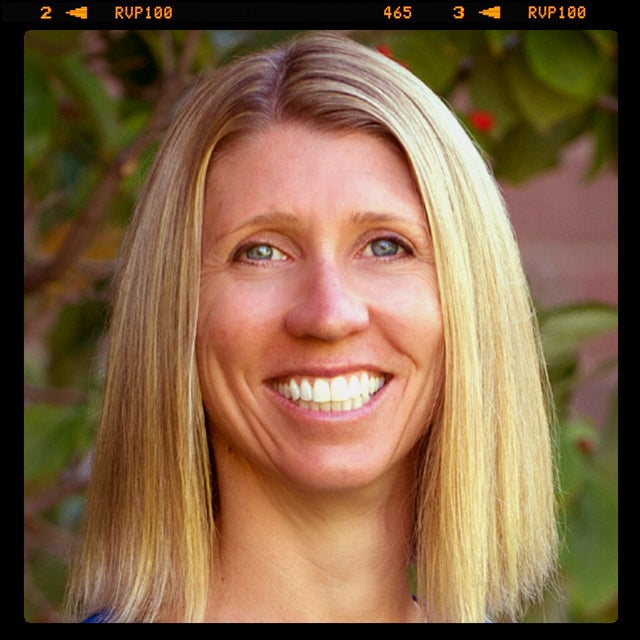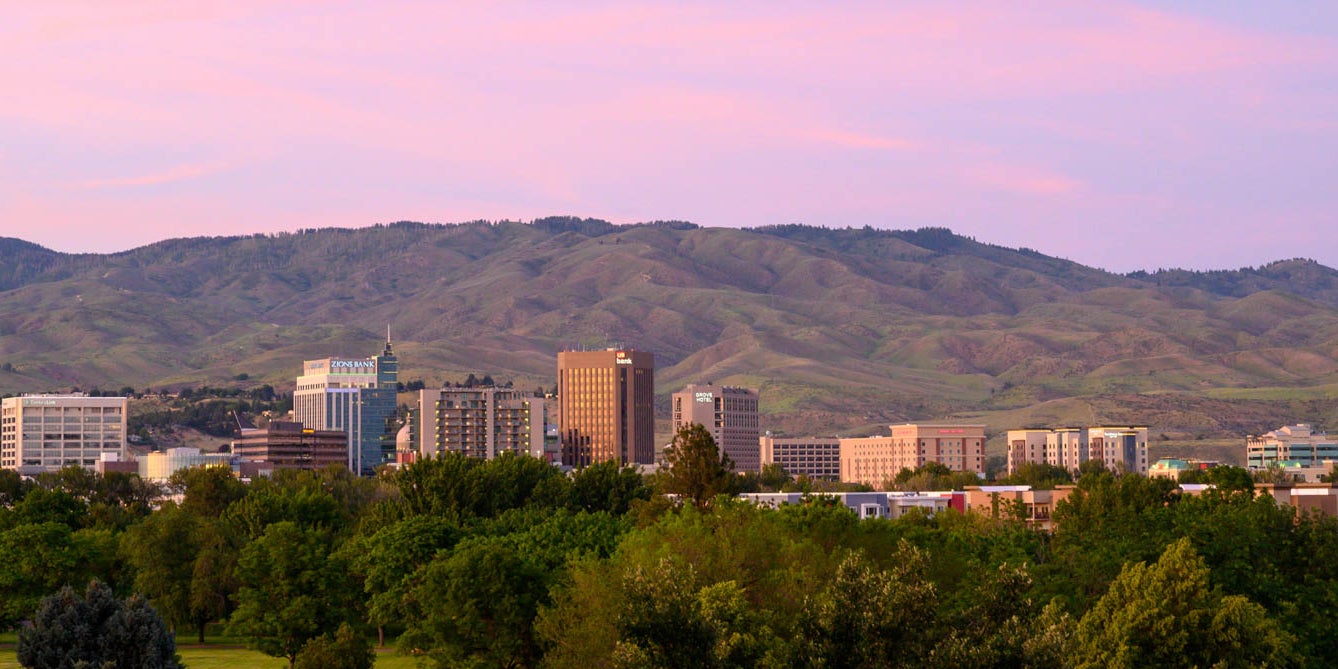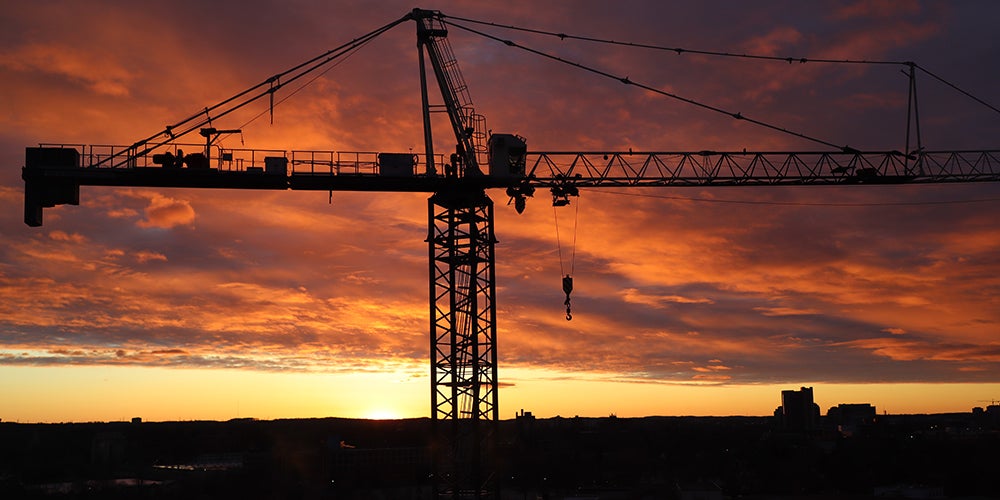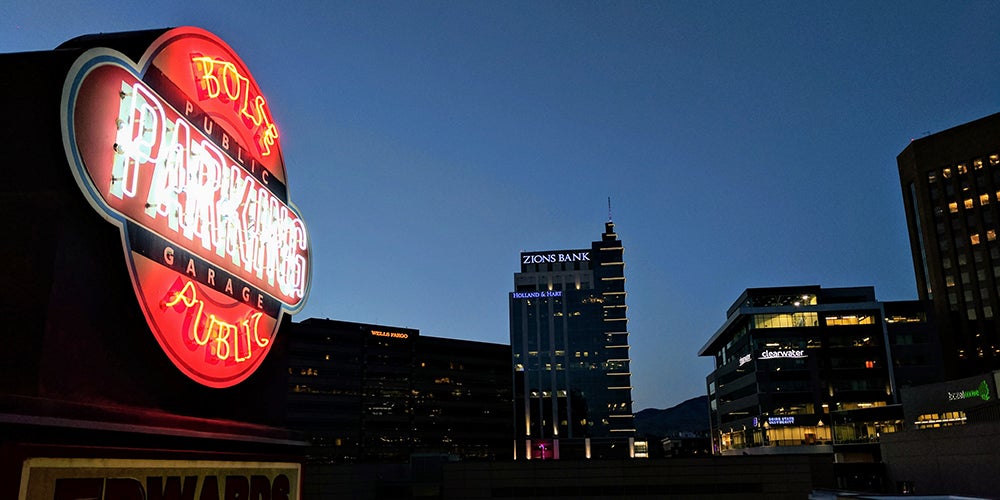The following reprint is a WRDC RESEARCH BRIEF, a publication of The Western Rural Development Center. The Western Rural Development Center collaborates with western land-grant universities and public and private sector partners to promote excellence in research, education, and extension for the prosperity of western rural communities. The original can be read on the The Western Rural Development Center website.

Dr. Saleh Ahmed is Assistant Professor in the School of Public Service at Boise State University. He is a core faculty member of Urban Studies and Community Development, Environmental Studies, and Global Studies programs. His current projects focus on climate justice and societal impacts of pandemics among minorities and other low-income population groups. Dr. Ahmed has an interdisciplinary PhD in Arid Lands Resource Sciences with a minor in Global Change from the University of Arizona.

Dr. Elizabeth Eklund is an environmental anthropologist focused on the intersection of nature and culture. Her work includes the cultural meaning of federally protected areas, natural and cultural heritage, amenity-based migration, and the experience of local and global change. Her doctoral research in northwestern Mexico focused on traditional canal irrigation and continuity and change in rural Banámichi, Sonora.

Dr. Vanessa Fry is Interim Director of the Idaho Policy Institute and Associate Research Professor in the Boise State School of Public Service. She has focused both her work and education on utilizing multi-sector, evidenced-based solutions to address persistent social, environmental, and economic issues and meet the current and critical needs in communities across Idaho and beyond. Dr. Fry is also an Adjunct Faculty Member at Presidio Graduate School in San Francisco where she received her MBA in Sustainable Management. In addition, Vanessa serves on the board of the Red Cross of Greater Idaho.

The American West has experienced rapid population growth in recent years. In 2020, when the entire nation was engulfed by the pandemic, the population influx did not slow down. This article looks at population growth in the Intermountain West and how an already divided society saw a widening gap between sectors as some businesses, particularly in the service industry, closed while “Zoom Towns” (Potter, 2020) thrived. While this pattern of growth will likely continue, inclusive planning and coordinated growth management are critical, so people in the region can maintain harmony without compromising community wellbeing, environmental, and other social and economic opportunities. Otherwise, low-income working-class people and struggling sectors during this pandemic will continue to be marginalized. However, with an eye to social justice, equity, diversity, and inclusion, the “New West” could become a template for the digital era.
Growth Story in the American West
The mythos of the American West is closely tied to farming, ranching, mining, and other productive/extractive industries, but over time the region is increasingly defined by a post-industrial, service-sector, and amenity-based economy. This transition has been thought of as the shift from the “Old West” to the “New West” (Krannich et al., 2011; Winkler et al., 2011). The New West experienced phenomenal population growth. For example, between 1980 and 2020, Idaho alone experienced a population growth rate of 94.8%, while the rest of the country grew by 46.3% (US Census Bureau, 2021).
This growth has been fueled by proximity to high-quality natural amenities, as well as the relatively low-cost of living. Adverse environmental impacts, such as wildfires and summer heatwaves, appear to have also influenced peoples’ decisions to move to various destinations in the amenity-rich American West (Lenthang, 2020). However, this growth comes at a cost. In recent years, people in the American West have seen increased traffic, road congestion, sprawl, disturbance of vegetation cover, along with a negative impact on wildlife, habitat fragmentation, and lowered farm output (Ahmed and Jackson-Smith, 2019; Krannich et al., 2011; Narducci et al., 2019; Esparza and Carruthers, 2000).

The Shadow of the Pandemic
When the COVID-19 pandemic hit the United States in March of 2020, early localized lockdowns in areas like San Francisco and New York quickly spread across the country. The repercussions were felt in rural areas as businesses closed, tourist travel ceased, agricultural products rotted in the fields, and businesses scrambled to allow employees to work from home. As the pandemic continued, the recovery in the U.S. has been K-shaped, where better paid financial and information services sectors were not as hard hit and have been recovering well, while leisure and hospitality industries continue to suffer (Saraiva, 2020).
This K-shaped recovery hit the emergent economy of the “New West” hard, deepening divisions between more affluent newcomers and long-term residents who often take service sector jobs as the opportunities in farming, mining, and ranching have declined over the decades (Graber, 1974; Krannich et al., 2011; Swette and Lambin, 2021). In 2020, jobs were lost as businesses such as restaurants, barbershops, and small stores closed. Since tourism decreased substantially, the people who work in those sectors, including small business owners, earned less than expected. This has compounded the challenges of both original inhabitants and the most marginalized. Limited social services compromise residents’ ability to meet their basic needs (Chan and Taylor, 2020) and the 2020 and 2021 government stimulus packages, with $1,400 relief checks and paycheck protection loans, alone are not sufficient. During this time, long-term, low-income residents have struggled with the rising costs of housing and other services (Barnhill, 2020). In Boise alone, rents went up 39% since March 2020 (Gamboa, 2021), and the housing market became more competitive (Mateo, 2021).
In contrast, high-tech and medical industries have experienced exponential growth. The number of people working remotely increased 21% during 2020, nearly four times the rate in 2019 (National Association of Realtors, 2020). This population, as well as retirees, faced changes to their lifestyles that nearly all Americans faced, like being unable to go out to eat, travel, or attend social and religious gatherings. However, high-skilled workers and retirees were confronted with only nominal changes to their income due to pandemic closures.
Many high-skilled workers had the opportunity to work from home, allowing them to relocate to areas that offer a high quality of living and/or affordability (Potter, 2020; Thompson, 2021). Cities like Boston, Los Angeles, San Francisco, San Jose, and New York City all saw residents temporarily or permanently leave (Frey, 2021). Although pandemic patterns may be reversing (Schneider, 2021), growth rate has been declining in large metro urban counties over the last decade (Kolko, 2021).

Seeking a Better Quality of Life During the Pandemic
Eric and Kari had been working as a software engineer and a machine learning engineer in the San Francisco Bay area, going into the office most days, but working fully remotely one or two days a week when the COVID-19 pandemic hit in March of 2020. In a matter of days, everyone found they had to switch to working fully remotely as offices closed. Like many of their co-workers, they were ready for the transition, but it was not exactly easy as the boundaries between home and work blurred. At least in Kari’s case, the office planned on reopening as soon as the “short” lockdown was over, but as weeks turned into months Eric and Kari realized they could do their jobs anywhere so they started looking for places to rent in different cities like Seattle and Denver, before ultimately taking a six-month lease on a home in Boise, Idaho. Within driving distance to California, they could rent a place with double the square footage for half the cost. The landlord also offered the much-needed flexibility of a short-term lease so they could return to the Bay Area when the office reopened. But as the closures continued and the company Kari worked for saw an increase in productivity, her company decided to remain remote and not reopen the office.
Rebound in the New West
Anecdotal evidence suggests that this pattern of high-skilled jobs becoming more dispersed will only continue. Businesses have found that jobs once thought incompatible with remote work became more productive and are re-evaluating. While jobs may become less tied to a physical place, people reside in geographic communities. Though cities do not appear to be negatively impacted as density lowers, according to Jeff Tucker, a senior economist in Zillow’s in-house think tank, for the receiving small cities – rural and exurban areas – the rush could be felt as “…a tidal wave” (Pulkkinen, 2021). These areas are usually less equipped to manage a rapid population influx because they have limited planning capacities. The growth narrative often overlooks concerns of equity, social justice, and may exclude low-income, working-class people in the region. Pressures on existing infrastructure, facilities, and the social fabric of the community disproportionately impact minority and low-income populations (Golding and Winkler, 2020).
However, there are reasons to be heartened by this growth. Amenity-based growth has offered economic opportunities to many rural and small towns, which were previously suffering from isolation, poverty, declining rural economies, and outmigration (Travis, 2007). Some evidence shows that affluent new migrants bring occupational, organizational, and leadership skills, which promote local entrepreneurship, creating a greater diversity of employment opportunities beyond the service sector (Krannich et al, 2011; Wall and Mathieson, 2006).
Nor are all migrants new. Software engineer Reece was from north Houston, Texas. He moved away for college, got married, and then started working for the company that he has been working with remotely over the last five years. Initially, remote work was not an option for his wife, but three years ago they returned to north Houston. The main reason was to be close to their families, but Reece noted, “The community we are living in also is really beautiful – lots of trees and outdoor running trails.” While Houston is a large city, anecdotal evidence also indicates that some technology professionals are able to “return home.” Others have shared how remote work has allowed their companies to expand hiring, and thus bringing new opportunities to formally disconnected areas. Brain drains and outmigration from small towns, and rural areas of highly-skilled professionals have historically been a challenge for rural America (Carr and Kefalas, 2009), but the new frontier of remote work appears to be changing that trend.

Conclusions: The Need to Plan for Change
In the shadow of the pandemic, growing social, economic, and health inequalities force us to rethink growth. Currently, small towns, rural and exurban areas are not equipped to deal with the unprecedented scale of population influx and geographical expansion. Furthermore, there is a need to address emergent social and political divisions, between long-term (multi-generation) residents that still keep ties to productionist industries like farming, ranching, and mining; and remote workers who may be part of a non-local company that nevertheless have a place in the community. This means host communities in the American West need to develop strategies for inclusive planning and growth management, which provide opportunities, growth, and well-being for all.
Localized planning can help address emergent inequities using appropriate laws and policies. Regional and local planning, and growth management policies need to be inclusive, placing social justice and equity at the center of economic growth and recovery. As remote work has become more common, there is a potential for a rural rebound, especially if low-cost internet services are equitably available; and housing and the cost of living remains affordable for both long-term residents and new arrivals.
References:
Ahmed et al. 2019. Impacts of Spatial Patterns of Rural and Exurban Residential Development on Agricultural Trends in the Intermountain West. Sage Open doi: https://doi.org/10.1177%2F2158244019871037.
Barnhill, F. 2020. Growing Pains: How Skyrocketing Home Prices Affect Who Can Afford the Treasure Valley. Boise State Public Radio/NPR in Idaho. https://www.boisestatepublicradio.org/post/growing-pains-how-skyrocketing-home-prices-affect-who-can-afford-treasure-valley#stream/0
Carr, PJ and Kefalas M. 2009. Hollowing out the Middle the Rural Brain Drain and What It Means for America. Beacon Press.
Chan and Taylor. “COVID-19 Lays Bare Vulnerabilities in U.S. Food Security (Commentary).” The Century Foundation. https://tcf.org/content/commentary/covid-19-lays-bare-vulnerabilities-u-s-food-security/
Esparza et al. 2000. Land-use Planning and Exurbanization in the Rural Mountain West: Evidence from Arizona. Journal of Planning Education and Research, 20: 23-36.
Frey. W. 2021. America’s Largest Cities Saw the Sharpest Population Losses During the Pandemic, New Census Data Shows. Brookings Institute. https://www.brookings.edu/research/the-largest-cities-saw-the-sharpest-population-losses-during-the-pandemic-new-census-data-shows/
Golding et al. 2020. Tracking Urbanization and Exurbs: Migration Across the Rural-Urban Continuum, 1990–2016. Population Research and Policy Review 39: 835-859.
Graber. 1974. “Newcomers and Oldtimers: Growth and Change in a Mountain Town.” Rural Sociology 39(4): 504-513.
Krannich et al. 2011. People, Places and Landscapes: Social Change in High Amenity Rural Areas. Springer.
Kolko. J. 2021. The Most Urban Counties in the U.S. Are Shrinking. 4 May 2021, https://www.nytimes.com/2021/05/04/upshot/census-new-results-county.html
Lenthang. “More People are Leaving California than Ever Before, Driven Out by Worsening Wildfires, Politics and the Skyrocketing Cost of Living.” The Daily Mail, 13 September 2020, https://www.dailymail.co.uk/news/article-8727961/More-people-leaving-California-wildfires-high-costs-politics.html
Gamboa, A.D. 2021. Boise rent prices continue to increase faster than anywhere else in the US. https://boisedev.com/news/2021/07/28/boise-rent-prices-up-39-percent-since-last-march/
Mateo. 2021. Boise Sees Nation’s Largest Rent Increase During Pandemic. https://1035kissfmboise.com/boise-sees-nations-largest-rent-increase-during-pandemic/
Narducci, J., et al. 2019. “Implications of urban growth and farmland loss for ecosystem services in the western United States.” Land Use Policy 86: 1-11.
National Association of Realtors. 2020. 2020 Real Estate Forecast Summit. December 10, 2020, https://cdn.nar.realtor/sites/default/files/documents/2020-nar-real-estate-economic-summit-lawrence-yun-presentation-slides-12-10-2020.pdf
Potter, L. 2020. “The Rise of ‘Zoom Towns’ in the Rural West. University of Utah Communications.” October 14, 2020, https://attheu.utah.edu/facultystaff/the-rise-of-zoom-towns-in-the-rural-west/
Pulkkinen, L. 2021. Western Cities See New Residents, Changing Vibe. U.S. News, https://www.usnews.com/news/cities/articles/2021-01-22/influx-of-new-residents-brings-changing-vibe-to-western-cities
Saraiva, C. 2020. How a ‘K-Shaped’ Recovery is Widening U.S. Inequality. Washington Post. 16 Dec. 2020, https://www.washingtonpost.com/business/how-a-k-shaped-recovery-is-widening-us-inequality/2020/12/10/baa6bc08-3aad-11eb-aad9-8959227280c4_story.html
Schneider, H. 2021. The Great Reboot: Pandemic-led decline of U.S. cities may be reversing. 4 May 2021. https://www.reuters.com/world/the-great-reboot/pandemic-led-decline-us-cities-may-be-reversing-2021-05-04/
Swette et al. 2021. Institutional changes drive land use transitions on rangelands: The case of grazing on public lands in the American West. Global Environmental Change, 66, https://doi.org/10.1016/j.gloenvcha.2020.102220
Esparza et al. 2000. Land-use Planning and Exurbanization in the Rural Mountain West: Evidence from Arizona. Journal of Planning Education and Research, 20: 23-36.
Thompson, J. 2021. How the Zoom Boom is Changing the West? Remote Workers are Flocking to Western Towns. HighCountryNews, https://www.hcn.org/issues/53.1/infographic-how-the-zoom-boom-is-changing-the-west
Travis, WR. 2007. New Geographies of the American West: Land Use and the Changing Patterns of Place. Island Press.
Wall, G. and Mathieson, A. 2006. Tourism, Change, Impacts, and Opportunities. Pearson.
Winkler, R., et al. 2007. “Social Landscapes of the Inter-Mountain West: Comparison of ‘Old West’ and ‘New West’ Communities.” Rural Sociology 72(3): 478-501.
Winkler, R., et al. 2011. “‘Old West’ and ‘New West’: A Regional Perspective In: People, Places and Landscapes: Social Change in High Amenity Rural Areas, Krannich et al. (eds.). pages 45-62. Springer.
U.S. Census Bureau. 2021. Historical Population Change Data (1910-2020), https://www.census.gov/data/tables/time-series/dec/popchange-data-text.html.